RV in Alaska
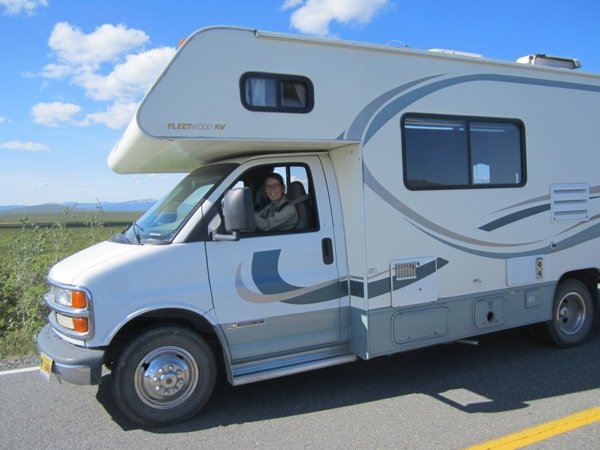
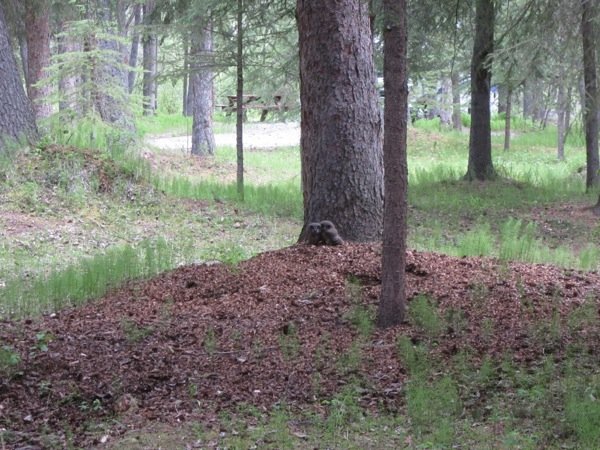

I have always been fascinated with life on the road. My fantasy runs more to Travels with Charley than it does with those monstrous RVs that hog the road (what DO they have in there?) getting 2 miles to the gallon. To roam freely like a turtle with its shell had become a real fantasy. And my fantasy vehicle is the RoadTrek. It's sleek and runs on diesel and costs a fortune (just about what I paid for my house that doesn't roll around, and that will appreciate, not depreciate). It's a RoadTrek I had in mind when I decided we would rent an RV in Alaska. Instead, I found website after website of big fat RVs to rent. So that's what we would do.
The company I found online boasted they were homegrown Alaskan. Rave reviews followed. I booked early and got a discount. I was ridiculously excited about this leg of the trip, and imagined sending photos of me at the wheel of our rig, grinning as I backed into a camp site.
From the start it was clear that choosing homegrown wasn't such a good idea. When we were ready to go, at 9 on the morning, I called for a pick up. The message said, leave a message, but call back as well; I don't return phone calls. So I called a while later and they said the rig would be ready at noon. At noon they said 1:30. At 2:30 they said they'd pick us up in twenty minutes. At 3:45 they picked us up. At 4:30 we rolled out of the parking lot in a vehicle with nearly bald tires, that rattled (loose heat shield?), that barked (hole in muffler?) that had a cracked windshield and, we learned after being honked at a few times, the left blinker didn't work. I won't even begin to list the problems inside, like the passenger seat that flopped backward and would not lock, or the refrigerator that froze all of our food, or the shower that leaked. Sitting in the RV felt like being suspended in a hammock as we swayed from side to side rolling down the road. It was not a good feeling.
First stop: Walmart. In my strongest moments I find Walmart a challenge. I staggered out with our food for the next nine days. Second stop: the airport where we hoped PenAir would have delivered our luggage that did not make it onto our return flight from St. Paul. It was supposed to be in at 4:30. It was not, but they promised it would arrive at 7:30. It didn't arrive then either.
So luggage-less and in our swaying vehicle we made our way out of Anchorage. A gloom settled into the RV as we both took in our situation. Our plan to drive the Denali Highway vanished as we realized this RV wasn't reliable enough to drive the dirt road. What if we got a flat? the RV rental refused to give us a jack. "You'd never figure out how to use it."
I read the description for a camping spot outside of Palmer, a suburb to Anchorage. "Beautiful views of the Matanuska Valley," it said. A series of RV stacked in a row occupied a vast, characterless field. "Beautiful," I echoed as Peter pulled in.
I hardly slept through the night under our polyester sheets as I went through the ridiculousness of this venture. Driving a big, clunky vehicle is not an adventure; it was just midnight anxiety. We woke to walk down a mosquito-infested dirt road in search of Hammond's Flycatcher. No bird but the walk did, for a moment, distract us from our situation.
The drive out the Glenn Highway is one of the most beautiful in the world. In the distance, the snowy mountains of the Wrangell Mountains. The black spruce that line most of the road give a sense of true wilderness. A Northern Hawk Owl swooped across the road, a Robin in hot pursuit. There was little room to pull over but Peter got the RV off the road and we ran back to find the Owl perched on top of a tree. A mate joined it and the two sat there, staring at the world.
Excited by our owls, we rolled forward. We had expected to already be in Paxson by this night, but the RV wasn't much good over 50 miles per hour, so we were short of our goal.
The Tolsona Wilderness Campsite at one point had nesting Great Gray Owls--what could be more thrilling? So we turned in there for the night. We had a site right next to a stream, an open and beautiful place to sleep. Turning off the engine of the RV was the sweetest moment. Peter leapt from the driver's seat, relieved to be done with the narrow, often shoulder-less road in a fat vehicle. We needed a walk, so headed toward the gravel entrance road, intending to go in search of those owls (a search we knew would be fruitless, but we had to try). A squirrel caught his eye, and when Peter focused on the squirrel he saw two little brown blobs at the base of a large spruce tree. "Owls!" he said, practically walking up to them.
Two baby Boreal Owls huddled together, staring at us. Their wide eyes were framed with white, but the rest of them was a downy brown, the fluff of babyhood. There is nothing as magic as an owl. But a baby owl--I was shaking with the excitement of this. Others staying at the campground caught wind of our excitement and came over to look. A little boy peered into the woods. I handed him my binoculars. "Look closely," I said. "You will never see this again in your life." I was speaking to myself.
Through the night I woke a few times, wondering if those little owls were safe. A family of Ravens had set up camp on the other side of the river. The baby Ravens--nearly full size--made a racket asking for food. I didn't trust those Ravens not to take the owls.
At three in the morning Peter woke to the noise of the baby owls begging for food. He went out and recorded their cries. Later in the morning we visited them both, eyes closed in contentment, perched on tree limbs off the ground.
And here is how my logic works: if we had a light and fast car, or even a smooth riding RV, we never would have stopped at this campground, we never would have seen those baby Boreal Owls. I didn't start loving the RV--that would be going too far--but I saw that it was a part of this magical evening and night sharing a campsite with baby Boreal Owls.
Me, smiling at the wheel of the RV (a fake smile); two blobs of Boreal Owl; close up of Boreal Owls--photo by Peter Schoenberger
St. Paul
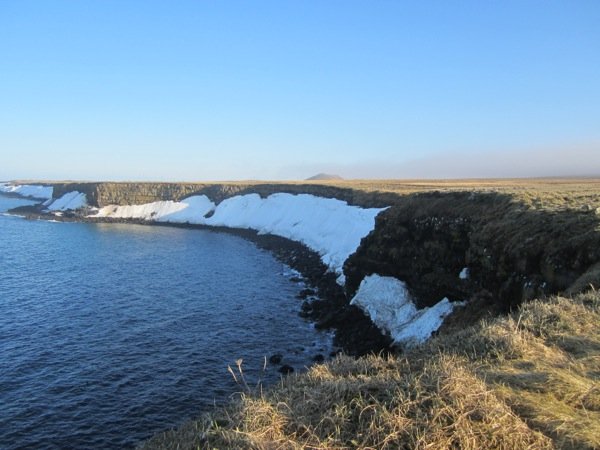
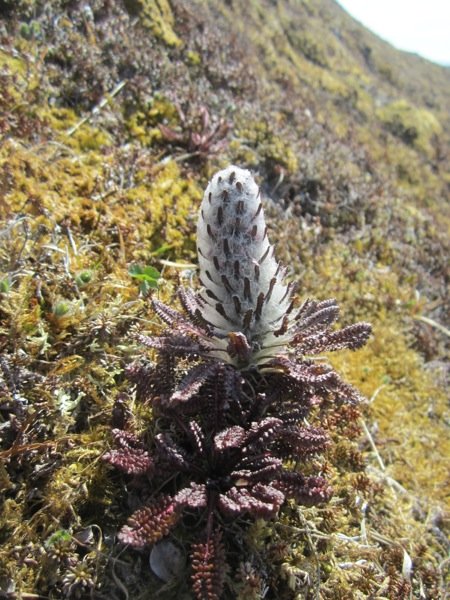
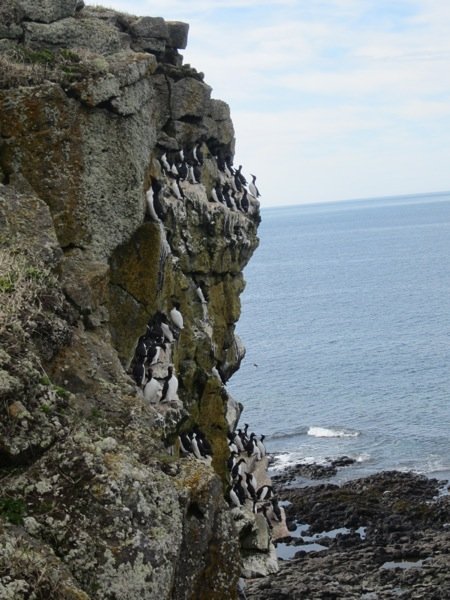
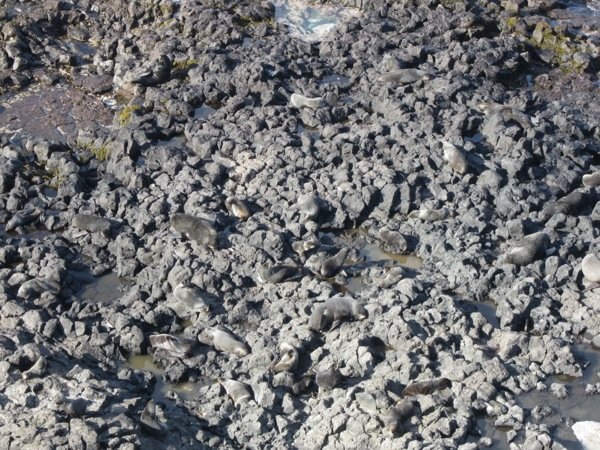
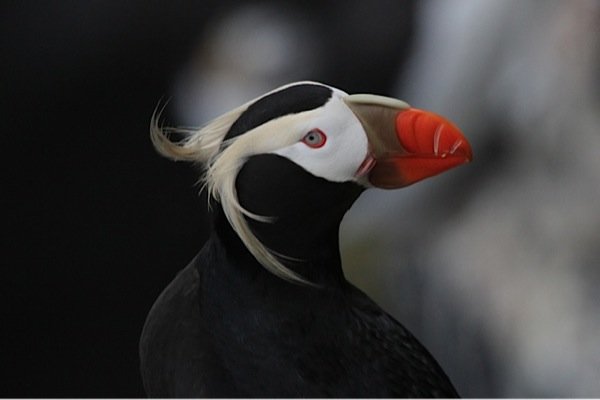
"Hey Mr. White Man, have a good life." The Filipino worker leaned over the staircase, cigarette in hand. He was calling out to the tall thin white man in front of me as we left the dining hall at the Trident Seafoods plant in St. Paul. St. Paul is a tiny island, one of two, along with St. George, which make up the Pribilof Islands in the Bering Sea. The Trident Seafood plant has the only food service on the island. So that is where we ate during the two days were were on the island.
The first time we walked in, the smell of fish smacked me upside the nostril. Interlaced with this was the tang of cigarette smoke. Once in the galley, the thickness of fried seafood took over. Our group of birders assembled meals from the salad bar and the range foods: rice, chicken, baked potatoes, and one night pasta, ravioli. The tomato soup was delicious; so was the carrot cake. We ate at long plastic tables, while a TV blared from one end of the room and a radio clattered from the kitchen. Everyone stared at the TV; no one spoke. The Trident workers, few of whom were white, ate in silence as well. They had just finished the crab season and a board in the hallway announced it was a good season: everyone would receive a $400 bonus.
"So Mr. White Man, where are you going from here?" I asked the young man. He had spent the past six months processing King Crab and was off to work in Wrangell processing salmon. "Today I got to see the seals for the first time," he said.
The seals are the Fur Seals. 1,000,000 Fur Seals migrate to the Pribilof Islands; in July, at the height of the breeding season, a seal pup is born every five seconds. While we were there, the males had arrived after months of swimming in the cold Bering Sea. We peered at them from blinds as they lolled on beaches or draped across the rocks. They were waiting for the "girls to show up," as one of our guides described it. Those females carry their babies for 11.8 months. So they arrive, give birth, then mate again before returning to the cold waters.
Our group spent our time at St. Paul watching all of the alcids that nest on the island, but also admiring those seals, which look like giant sausages on land. They would scratch with their flippers, and some would tangle with each other, but most just slept, the lazy sleep of an animal that has not been on land in months.
St. Paul is not an easy place to get to. We flew from Anchorage, stopping for fuel in Dillingham, and then flew on to St. George where some passengers deplaned. St. George is St. Paul's sister island, and is often shrouded in fog so few flights actually land. We got out of the plane under a cold blue sky and walked the airstrip. As we admired the views, cannons popped off in the background to set off the birds, which otherwise take over the runway. There, I saw Grey-crowned Rosy Finch, a large rose hued finch with a clean grey cap, and Red-legged Kittiwakes for the first time. I spoke with a woman who lives on the Island. She surfs offshore and that afternoon was going to kayak to the point. It seemed like a small paradise.
On the final leg of the journey I learned that the woman next to me was on her way to St. Paul to make it her home. Her young son and daughter sat in the seats behind us. Her husband was doing weather work on the island and had been living there since April. "I had some movies to see," she said with a laugh as a way to explain why she was only now arriving at her new home. "I'm not an island person."
St. Paul would be an interesting place to call home. There is a cluster of tidy houses, a Russian Orthodox Church and one store that sold 12 ounce bottles of water for $2.99 and four frozen cobs of corn for $13. There is some tourism on the island because though it is also frequently fogged in, it is more accessible. The island Native corporation (TDX) has also hired three young men, all fantastic birders, as guides to take visitors around. They greeted us at the airport, and walked us to our rooms at the King Eider Hotel. To call this a hotel is a bit of a stretch. The "hotel" is a hallway that runs parallel to the waiting room of the airport. Spare, clean rooms awaited us, with a bathroom down the hall. Through the night, the northern sun streamed through the thin curtains.
Right away we headed into the field to walk a marshy patch near town. An Arctic Fox worked the edges of the marsh, delighting all of us. The fox are so numerous, prowling the cliffs for birds or their eggs, that by the end of the trip we were less excited by them.
The land is low, dried grasses with a few wild flowers coming into bloom--buttercup and a fuzzy lousewort. I could see that by mid-summer the island would be a riot of color. And a riot of baby birds. The island is where a range of Alcids nest and they were all clamoring at the cliffs that ring the island. On the next day we walked the top of those cliffs, peering over at the ocean, then snow that still skirted the cliffs, a reminder of the winters in this exposed place. Birds speckled both the snowfields and the cliffs, often just feet away from us. Least and Parakeet Auklets, Horned and Tufted Puffins, all clung to the cliffs. Common Murres with their white bellies and black backs (which make them look like Northern Penguins) sit in a bunch while the Thick-billed Murres line up in a row, often with their backs to the water. In between these alcids both Black-legged and Red-legged Kittiwakes zoomed by, often carrying nesting material. All of the birds were enchanting, but the Tufted Puffin is a favorite, with those fantastic tufts, a movie star of a bird.
A few low hills rise up on the island, providing great views in all directions to lakes and to the Bering Sea. From these hills we also hoped to be able to scan the wide sky for a White-tailed Eagle that had been seen a few times on the island. We never saw the eagle, but during those eagle watches I was able to listen to the lively song of the Lapland Longspur, admire more Gray-crowned Rosy-finch and a few Snow Buntings.
During spring and fall, migrants are often blown off course, and they end up here on the island, hunkering down in the crab pots, or in some of the ditches around the island. One evening we drove the bumpy dirt road to the northern end of the island. We fanned out, walking to the top of a hill, when our guide emerged with a big grin. "Wilson's Warbler," he said a little out of breath. It's a bird all of us know well from our homes in the lower 48. But to see it there amidst birds that were exotic to us was an odd treat. We chased down hill, then I spied the bright bird, put my binoculars to my eyes to see its dark black cap, and vibrant yellow body. A piece of home in a place that felt like a stark and beautiful and hard place to call home. I wished that mother and her two kids luck in the new St. Paul lives; I wished all of those fur seals good breeding; I hoped the tall white man has a good salmon season.
photos: the cliffs of St. Paul; Wooley Lousewort; Murres on the cliffs; count all of the Fur Seals!; the elegant Tufted Puffin, photo by Peter Schoenberger
Breeding Plumage
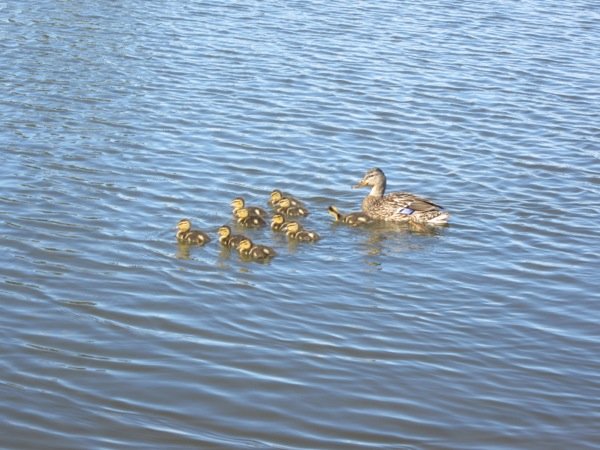
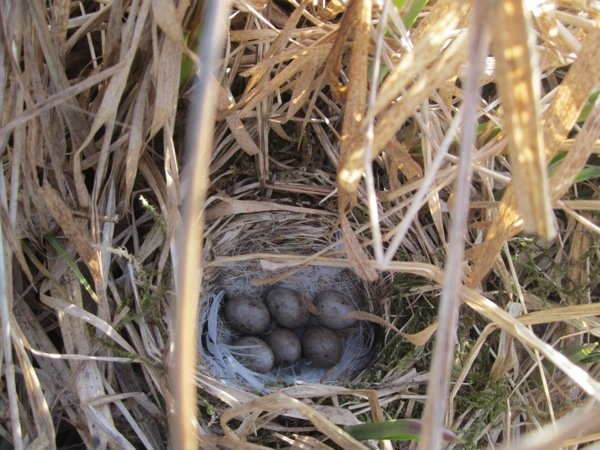
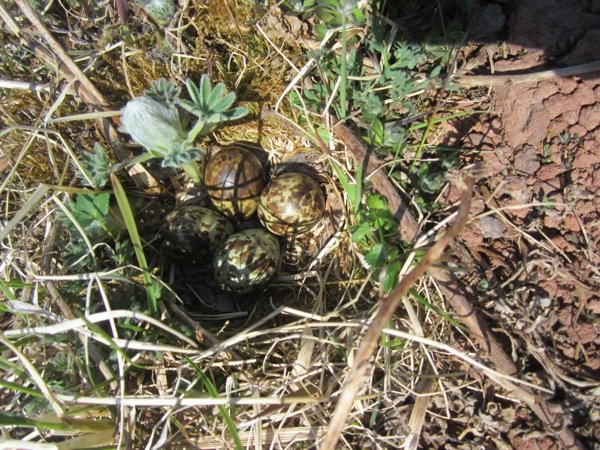
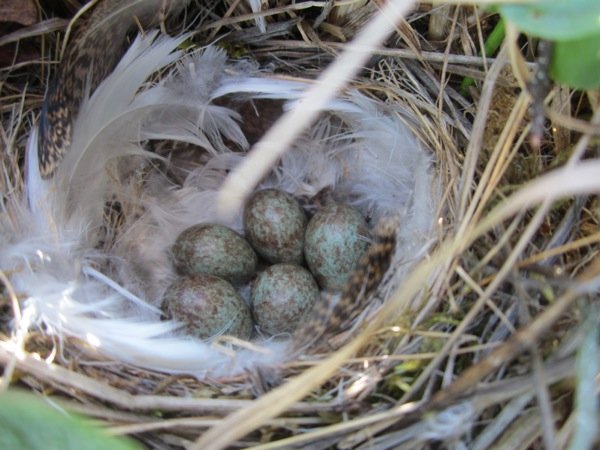
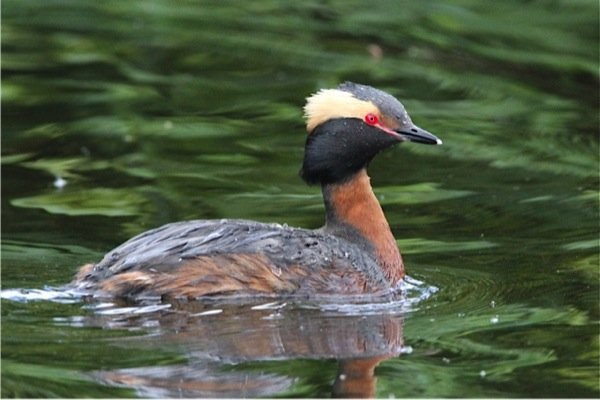
If I hear the words "breeding plumage" one more time I'll scream. When you travel for 18 days with focused birders, in June, in Alaska, a lot of what they are excited about (ok, what we are excited about) is seeing birds we are familiar with, but not in their breeding plumage. With some birds the transformation is extraordinary--they become different birds--and with others the change is minimal. One of my favorite birds, the Rusty Blackbird, has little variation between breeding and not. But the subtle shift from brownish bird to one that glows a range of blues and purple blacks is marvelous. And the Rusty Blackbird has a wonderful whitish iris, and makes a sound like a squeaky door. That this is one of my favorite birds is odd but my fondness for the bird is perhaps because it is overlooked in favor of those birds who do have showy breeding plumage. But also, it is a species in decline and I feel protective of animals that are not as colorful or charismatic that are threatened.The first time I saw a Rusty Blackbird Peter said to me, "This is a bird that might be extinct in our lifetime." That's a sobering thought. When our guide here in Alaska pulled a Rusty Blackbird out of the tundra near Nome, I was thrilled, while some participants sat in the van and waited for the next more exciting find.
All of the birds are here in Alaska to breed. In Nome, Anchorage, and on St. Paul Island, we have seen courtship displays, mating, nest building activity--lots of birds carrying tundra grasses to make nests--nests themselves, and some nests with eggs. It's a special thing to see these nests, built on the ground or in willow bushes as there are no trees in Nome or in the Pribilofs. There have been Hoary Redpoll nests, Red-Necked Grebe nests that appeared to be floating on the water, American Golden Plover nests on the hard Tundra at Wooley Lagoon. At a pull out near Potter Marsh outside of Anchorage an Arctic Tern had settled in right by the road--a serious bad choice for nest location--and dive bombed us when we got out of the van. On St. Paul in the Pribiloffs, a Lapland Longspur bolted from its nest as we walked out toward a marsh, and a Rock Sandpiper left its nest as we drove by. In each case, we looked quickly, not wanting the mother to leave her eggs uncovered for long in the cold northern air.
And some birds have already hatched. Cackling Geese and Mallards lead the pack. But at Westchester Marsh in downtown Anchorage we saw baby Mew Gulls--little gray spotted puff balls--and at Potter Marsh baby Sandhill Cranes, rusty puff balls.
Across from Potter Marsh is a strip of water, before the train tracks that line Cook Inlet. Our guide led us across the busy Seward Highway to peer into this strip of water. Karen, who has been a great spotter for all of this trip called out, "Grebe," with her Texas accent. And there, sure enough, was a Horned Grebe paddling in the water. It had wheat-yellow tufts that framed black cheeks and deep red eyes. It looked like it was wearing a beautiful, slicked back helmet. Its rusty chest gave way to a grayish patterned back. This was nothing like the black and white bird I had seen in New York State. This was the Horned Grebe in full breeding plumage. For once, those two words did not make me want to scream.
photos above: Mallard and babies; Lapland Longspur eggs; Rock Sandpiper eggs; American Tree Sparrow Eggs; Horned Grebe in breeding plumage! photo by Peter Schoenberger
Nome
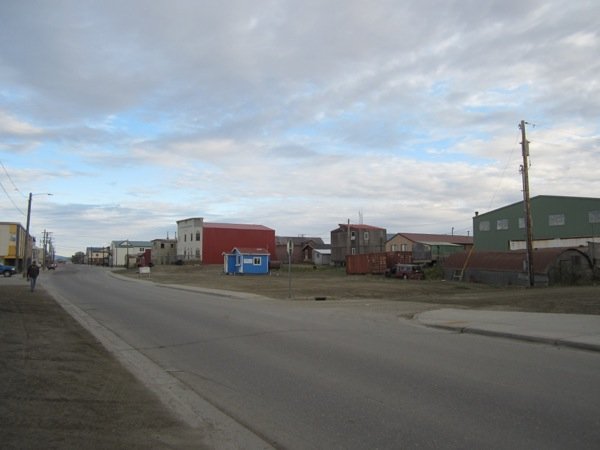
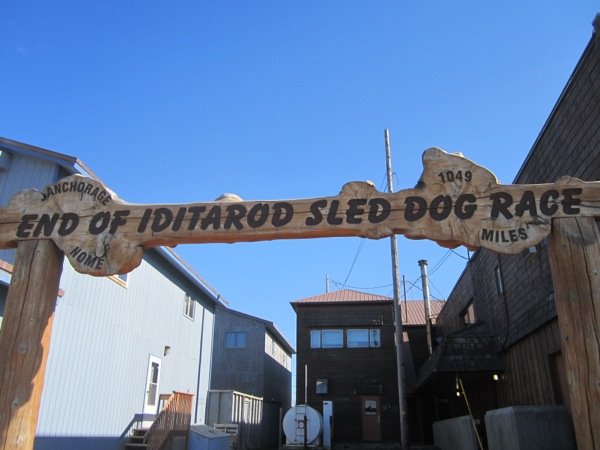
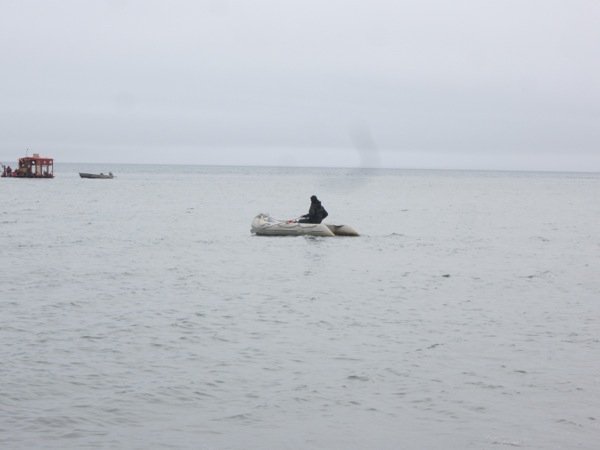
Usually when I travel I contemplate: could I live here. Most of the time I conclude yes, and often fantasize the different life I would have if I moved to Wyoming, returned to Tucson, set out for northern Maine. But on this trip I have not imagined living in these isolated Alaskan towns. I feel the shadow of winter even amidst the spring abundance and the long days of sunshine.
The other day I stepped into a tiny gift shop in Nome. A young blond woman greeted us, and like most conversations in Alaska began with where we are from, why we are here. I quickly turn the questions around, more curious about why someone lives in Nome. She moved here from Utah with her husband, who is originally from Anchorage. They thought they would come for just a few years, but have had two children and plan on staying. "I love it here," she said, as radiant as the sun itself. She loves the pace of life, so much slower than Utah. She loves how neighborly people are, helping out in any situation.
I have not gotten a feel for this town at all as we drop into our hotel late--around 9 at night, under a high sun--eat, and fall asleep only to head out early the next morning in search of more birds. The hotel we are staying in could be a hotel anywhere in the world. Perhaps the only difference is that an animal channel runs continuously in the lobby on a large TV, not the news or a basketball game. And those who clean the rooms in the morning are all men, from a range of places (many Asian, some Native). One tells me he moved here two years ago for work after years of unemployment in Los Angeles.
Our group has stuck to eating at three locations: a place with a very un-appetizing name, Airport Pizza, that actually has fairly good food; Milanos, which serves both pizza and sushi (I can't bring myself to order sushi at a place called Milanos), where the server is Korean; and Subway. Until a week ago I had never eaten at a Subway; now I can say that I've eaten lunch from there every day for a week. Some days I've had breakfast there as well. And though it may seem like I'm complaining, I'm actually grateful that we are not eating at the place that advertises BBQ Chinese.
It is strange to be such a distant tourist; usually I get my hands dirty exploring back alleyways and talking to locals in cafes (or in this case, bars). But we've stayed together as a group, pointing our lens out to the birds we've come to see.
Still, as I've walked through town I've noted the bust of Amundsen. I know Amundsen from his South Pole feats (that is, first to the Pole), but now know that he flew over the North Pole in 1925. I have noted the plaque that celebrates that Wyatt Earp came, established a saloon, and left town with $80,000 in 1901. And, of course, Nome is the end of the Iditarod, the annual dog-sled race that commemorates that moment in 1925 when sled dogs brought serum from Anchorage for the diphtheria that was killing off the city. Imagining the winter here I have even more respect for those mushers.
Nome is a gold town. In 1899 three Swedes discovered gold and a year later the population hit 12, 500. There were bars and saloons and a good Red Light District. In this sense, Nome is a Western town with wide, empty streets and a love of its rough past. The air after rain smells like the desert, not mesquite, but the smell that comes when rain hits dust.
In Nome, people are still searching for gold off shore. Within sight of town are several dredges working the bottom of the Bering Sea. When I walked out the beach the other day, black sand under my boots, the cold of the water licking my cheeks, I saw a young man launching his inflated boat to return to his dredge. "Do you need help?" I asked. He shook his head no, timed his launch to the wavelets and pushed off, only getting his boots a little wet. As he rowed his dinghy toward the dredge, the Bering Sea looked vast and cold. Finding gold has never been easy business. Our group leader ran into a man at the gas pump filling five containers with gas to run his dredge. "I do this every day," he said. With gas at $5.95 a gallon, finding gold isn't cheap either. But we're all looking for gold in one way or another and as we know, the hunt is never cheap.
I walked a bit further and a young man caught up with me, wearing but a long-sleeved shirt while I had on three layers of clothing. He had two corgis bounding about with him, both black and white. They trotted up to me, joyous in the wind. "How do those dogs do in the winter?" I asked. Clearly I am obsessed with how someone gets through a winter out here--including the dogs. He hesitated a moment. "They look like porpoises bounding through the waves, only its snow," he said. And with that image, I turned around and headed back to the hotel.
Photos above: Main Street Nome; The end of the Iditarod; Young man heading toward his gold dredge in the Bering Sea